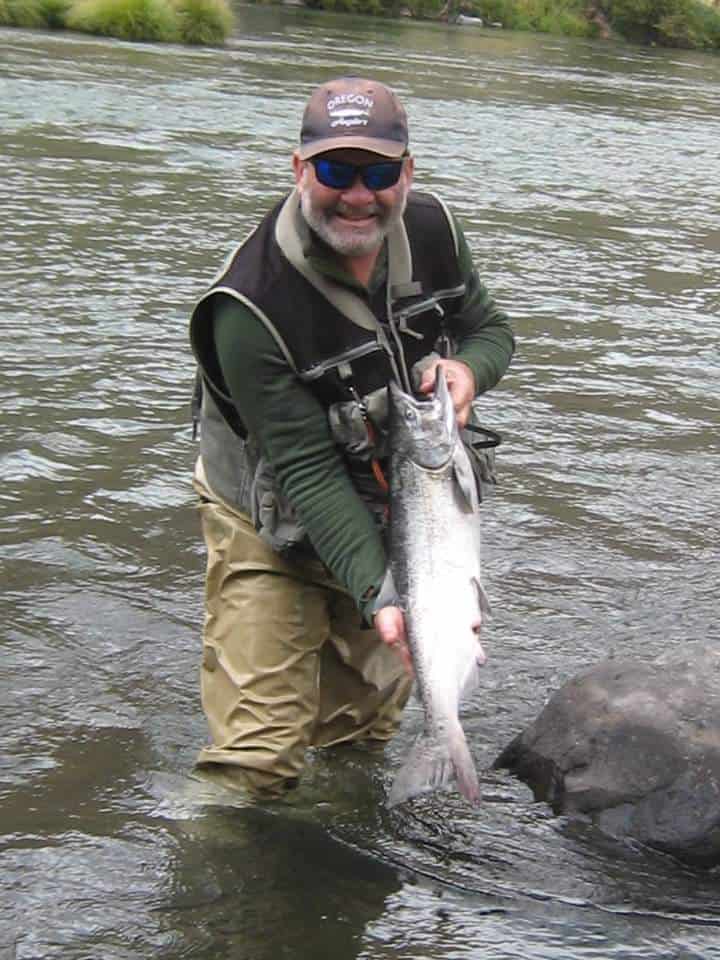Of all the great places to fish in Oregon, the Deschutes River is arguably the best known fishing destination.
The big Central Oregon river built its reputation largely as a fly fisherman’s paradise, a sunny place where big wild rainbows and much bigger summer steelhead will slam a fly with authority and fight like a champion.
The river drains a massive swatch of the center of Oregon, from the eastern slopes of the Cascade Mountains as far south as Klamath County and flows northward, getting better as it goes.
Even its tributaries (like the Crooked and Metolius and Fall) are famed for their great fishing.
Famous Deschutes River Fishing
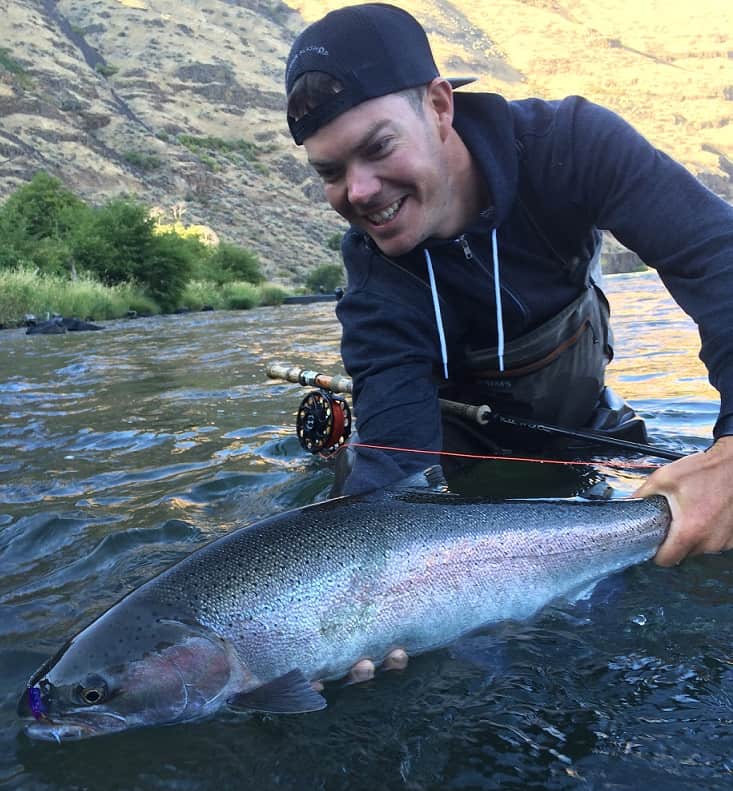
We feature the Deschutes prominently in our article, Best Fly Fishing Rivers in Oregon.
But you don’t have to take it from us. Ask just about anyone.
For just one example, well-known fly fisherman Harry Teel, who literally wrote the book on fishing this part of Oregon (Fly Fishing Central & Southeastern Oregon), considers the Deschutes “probably the finest overall fly fishing river in western America.”
The river has multiple fishing opportunities and presents a fair bit of different types of stream types.
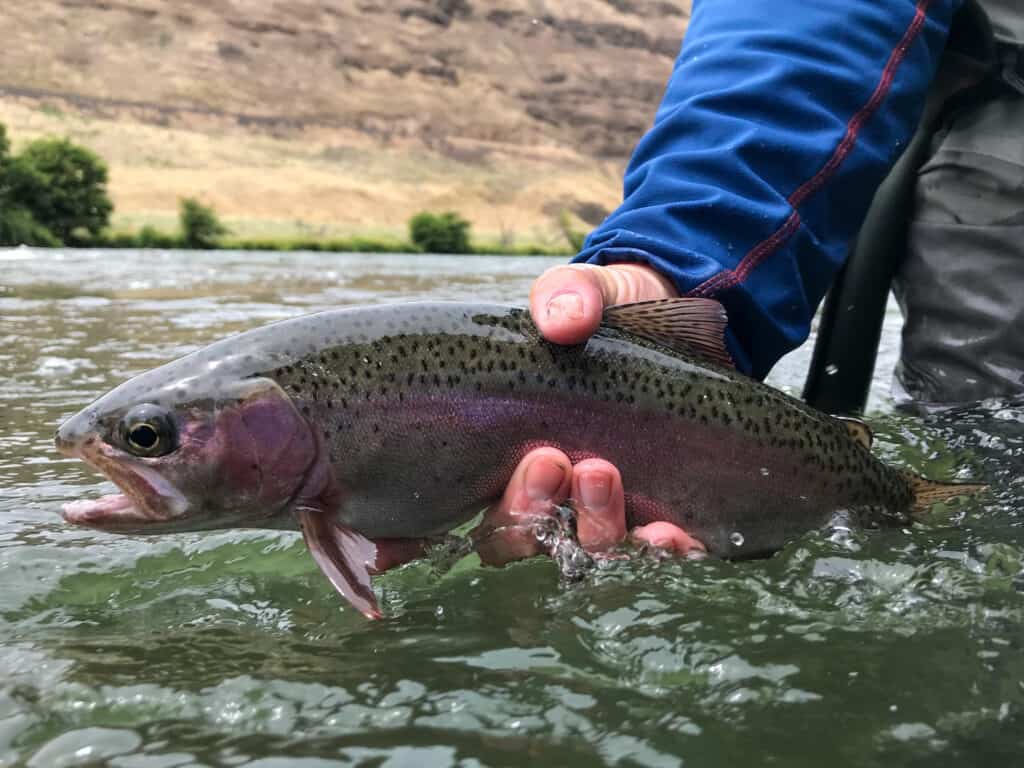
But its fame derives primarily from two related species of native fish: native rainbow trout known as redsides, and summer-run steelhead.
The steelhead, with both native and hatchery runs, are rainbow trout that migrate as youngsters to the ocean like salmon and return jumbo-sized.
The Deschutes also is home to plenty of native whitefish and a very small number of native bull trout, which is a char like brook and lake trout.
Bull trout can grow to massive size but are highly protected in most of Oregon and must always be released unharmed if caught in any Oregon river. (The state’s lone legal harvest of bull trout occurs in Lake Billy Chinook, a large reservoir on the Deschutes.)
Besides the steelhead, the Deschutes also is home to some of Oregon’s other famous anadromous fish.
There is a fall run of Chinook salmon that offers a regular fishery. There also is a spring Chinook run that the Oregon Department of Fish and Wildlife opens to harvest when healthy numbers are expected.
Coho salmon return to the lower river as well. Management changes at the big hydroelectric project that forms Lake Billy Chinook allow salmon and steelhead, including sockeye salmon, to be reintroduced into upper areas of the Deschutes and tributaries.
The new water regime, we should point out, has been controversial with anglers. It has changed some of the usual patterns in the fishery and local anglers have had to adapt while they continue to try to encourage officials to tweak the water releases.
The Deschutes also has non-native species, including some middle stretches with good German brown trout fishing and plentiful Eastern brook trout in the far upper river, where the state record for this char was caught.
Smallmouth bass have made their way into the lower river from the Columbia River.
This article is intended as an overview of the Deschutes River’s many fishing opportunities.
Some of the basic information listed below in this article will link to other sources of free information with more depth.
Anglers looking for a really deep dive might consider some of the books available on this great river, including some older classics.
Dave Hughes’ book “Deschutes” has inspiring photography and is informative for anglers. Scott Richmond is another regional fly fishing expert and provides lots of details in the versions of his “Fishing Oregon’s Deschutes River” guide.
Fishing Regulations and Boating Rules
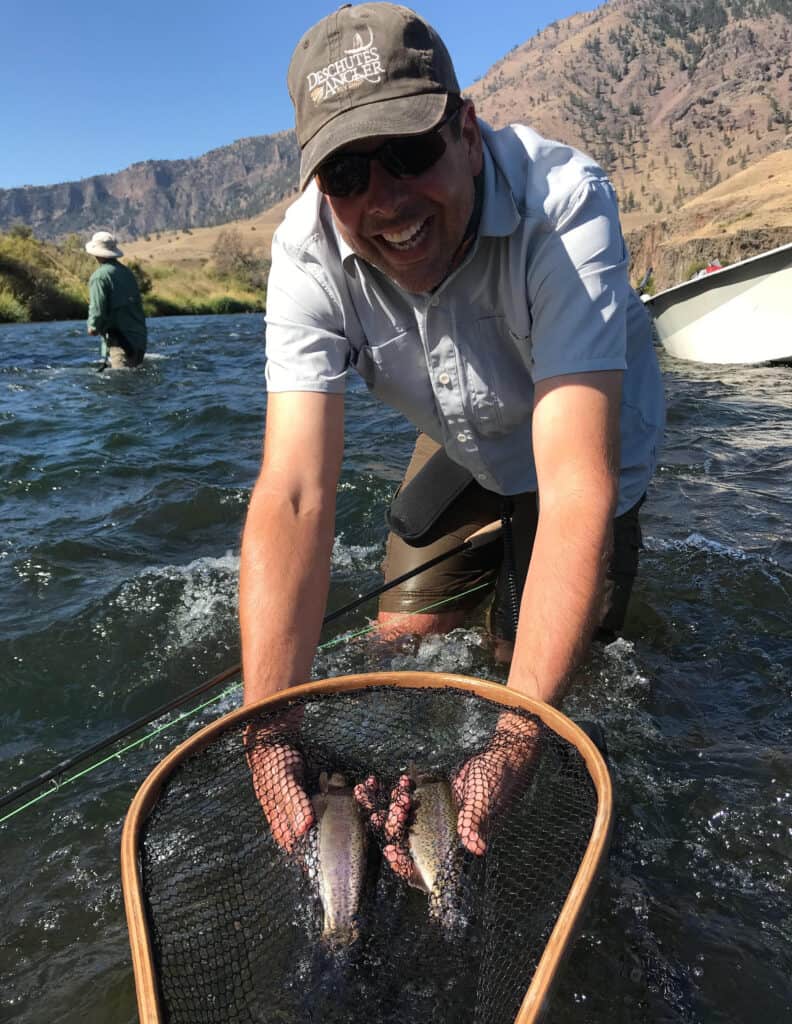
A few points to make: The Deschutes is largely managed for fishing with artificial flies and lures. There is a small area open to bait fishing aimed at the salmon fishery, but that’s it.
Fly fishing is the primary pursuit, but spinners, spoons, jigs and other artificial lures are allowed and fairly often deployed for steelhead.
Note that molded soft plastic lures are considered bait under Oregon rules, so don’t try to get away with those realistic worm imitations.
Another thing to note is that while Oregon regulations allow a modest harvest of a couple rainbow trout on some parts of the Deschutes, including a slot limit based on size on the lower river, know that most anglers here traditionally practice catch and release with native redsides.
However, hatchery-marked steelhead and non-native trout are considered very acceptable to take for dinner both under the official rules and common practice, as long as ODFW has opened the season. And keeping as many bass as you can catch in the lower river will make most trout anglers happy.
Please: Find the latest regulations before fishing the Deschutes or any other water, especially those with wild fish.
In recent years, ODFW started closing the steelhead fishery at times due to low returns, but better counts at Bonneville Dam can trigger a mid-August opening from Moody Rapids in the far lower river up to Pelton Dam near Warm Springs.
There’s a link at the bottom of this article to the newest rules.
Finally, boaters need a pass on the lower river. Find the details on that at recreation.gov.
Also, anglers who fish on Warm Springs land, such as the west bank bordering the reservation land, will need a tribal fishing permit. For details, go to the Warm Springs permit page.
The remainder of this article is organized by river section, loosely based on fishing opportunities and ODFW regulations.
Fishing the Lower Deschutes River
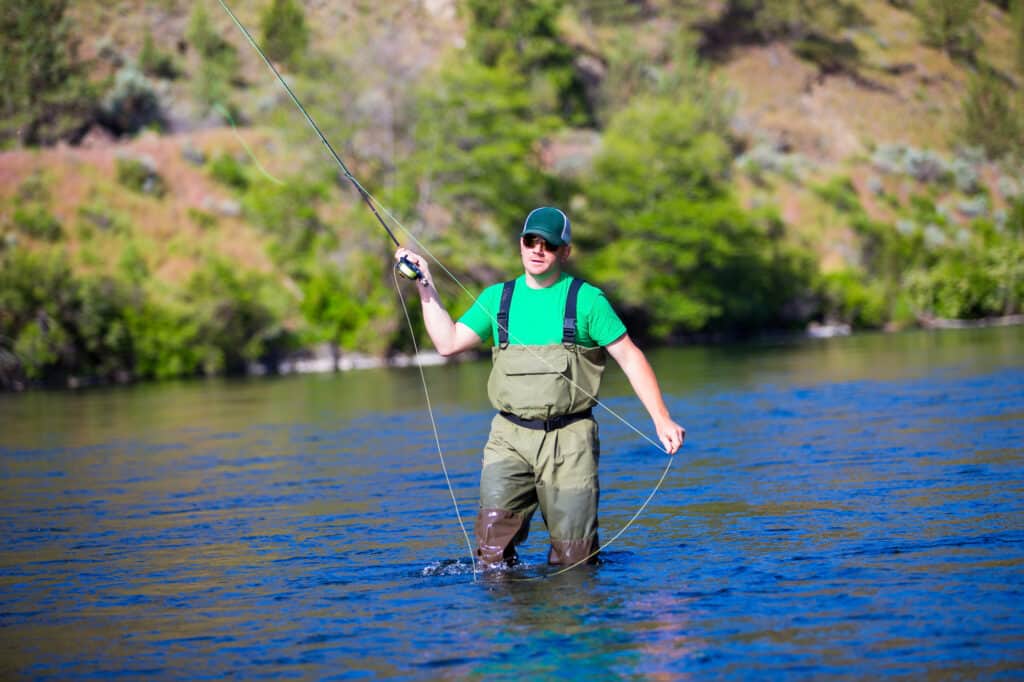
When people talk about the Deschutes, this is usually what they mean. While the upper river has plenty going for it as a trout stream, this lower 100 miles of river from the Pelton Dam down to its mouth at the Columbia River is world class.
Not only does this river section have great numbers of native redside rainbows year-round, but its seasonal steelhead fishing can be great. Add in the salmon runs and the lower river is awash in angling options.
Many consider the small town of Maupin in Wasco County to be the heart of the lower Deschutes River’s fishing community.
Maupin has fishing guides and fly shops to provide everything needed to be successful here. In fact, author Jay Zimmerman in The Top Ten Guide to Fly Fishing rates Maupin as the third-best fly fishing town in the entire U.S.
Nearby areas including around Bend also provide plenty of fly fishing services and equipment aimed at the lower Deschutes River, because it’s the biggest fly fishing draw in Central Oregon.
Lower Deschutes River Trout Fishing
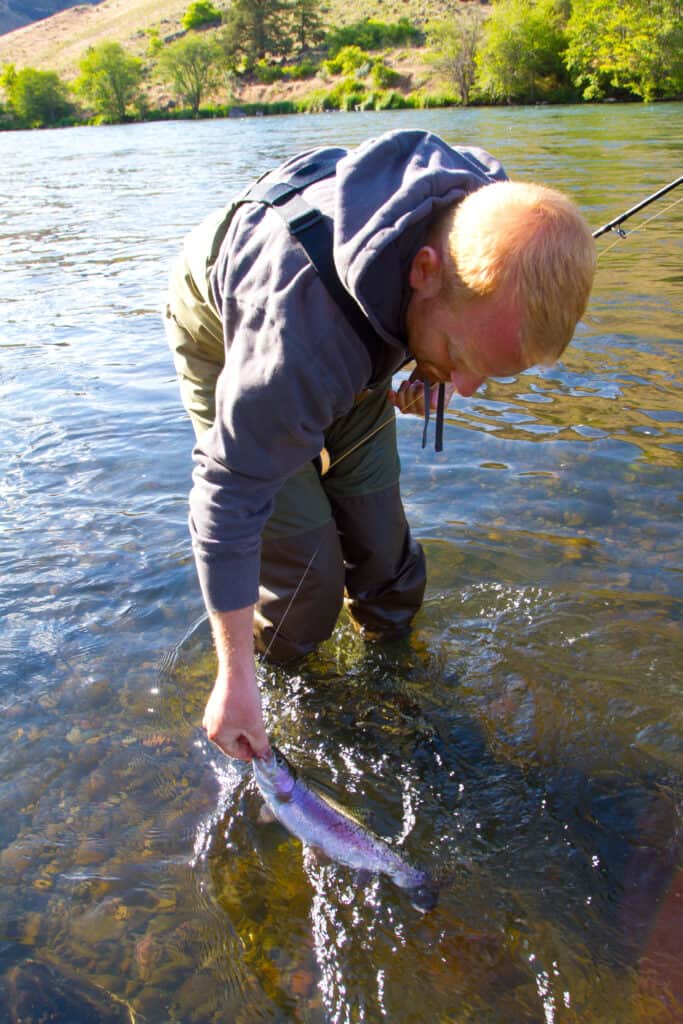
The trout fishing in the lower Deschutes River is often phenomenal and nearly always worthwhile.
The salmon fly hatch in May is legendary, bringing about suicidal tendencies with the trout. (Find more on that in our article, Fly Fishing the Deschutes River Salmon Fly Hatch.)
Many other hatches here stretch the fishing across every season.
The redsides here aren’t the largest in the state (see the Williamson River for that), but they are numerous and fierce fighters.
Typically redsides might run 10 to 14 inches. Bigger specimens get into the upper teens or in the 20-inch range.
Where to Fish for Trout on the Lower Deschutes
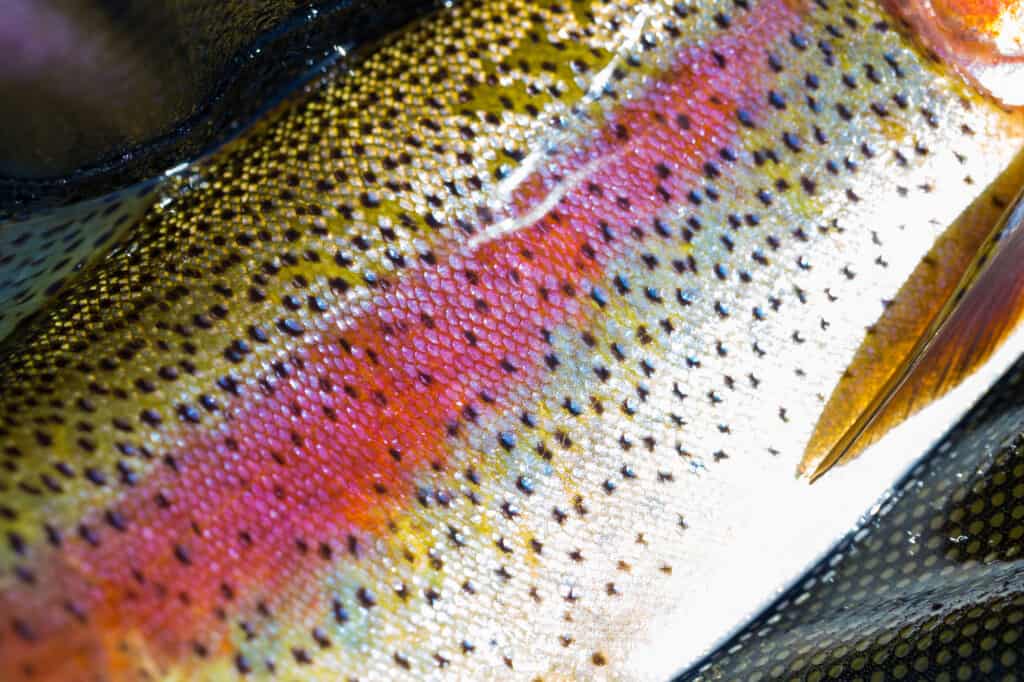
Most fly anglers chasing trout do so around Maupin and upriver to the deadline at the Pelton dam. There are some great floats through here, but note regulations that require you to get out of your craft to fish.
There is some decent bank access in spots, but you’ll need to work for it a bit and learn the river.
Note that there are some sections of the river along the Warm Springs Indian Reservation with seasonal fishing and other regulations, while lower sections are open year-round.
Downriver about six miles from Maupin, the White River comes off the eastern flank of Mount Hood and adds silt to the main river when it carries glacial melt in the warmer months, making fly fishing more challenging in cloudier water.
Another challenge is the lowest 25 or so river miles that flow through Macks Canyon, a roadless area, much of which can only be reached practically by boating through it from above.
Anglers can hike or mountain bike into the lower section from near the mouth. The canyon is remote and going through it with expert guides would be a good idea.
Brush up on your basic trout fishing skills with this article.
Lower Deschutes River Steelhead Fishing
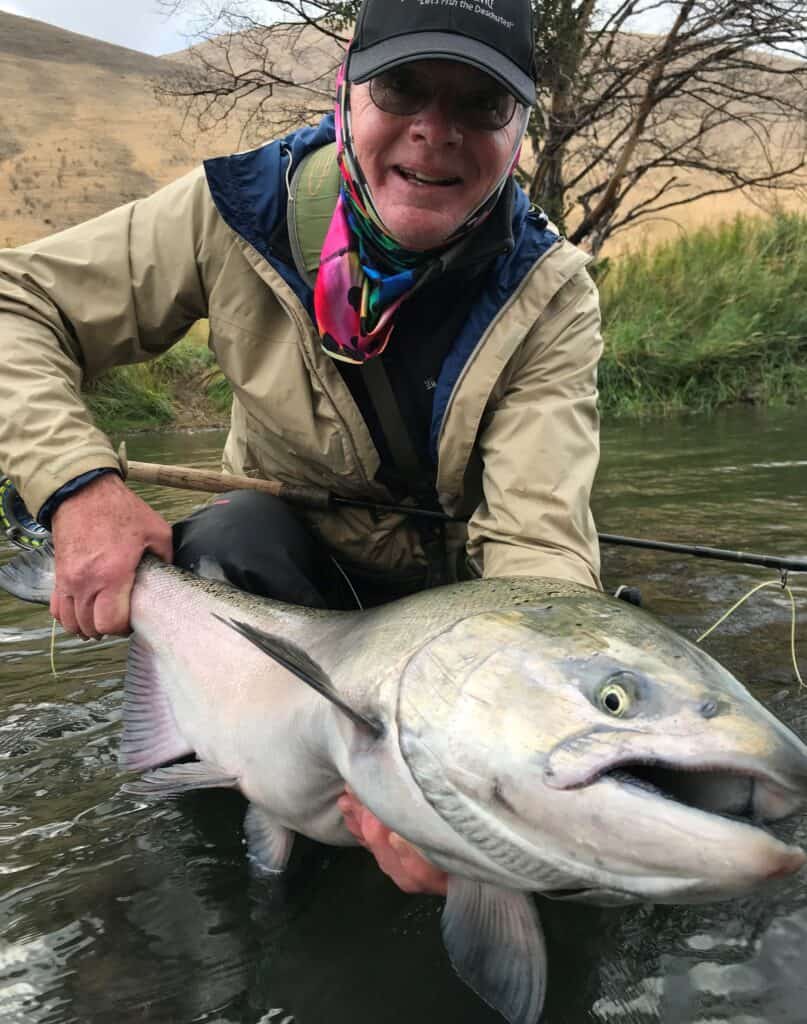
Summer steelhead arrive in the lowest sections of river closer to the Columbia River in great numbers starting in July, building throughout August and peaking in late August and throughout September.
As mentioned earlier, always watch for rule changes before planning your fishing trip. Currently, steelhead fishing may remain closed in the lower river during low run years, or it may open in mid-August above Moody if the count of fish passing Bonneville Dam is sufficient in July to allow a fishery.
The Deschutes below Moody, as well as a nearby Columbia River area, is a sanctuary zone closed to fishing seasonally (July 15-September 15) to protect upriver fish that pause in the cooler Deschutes flow during the hottest months before continuing their migrations up the Columbia once things cool off.
Late September into early October can be good before this fishery near the mouth of the Columbia fades for the year.
As hinted above, some of these steelhead are bound for the upper Deschutes itself, while others use the Deschutes as a temporary refuge from the much-warmer waters of the Columbia River. The temporary residents really boost the steelhead numbers in the lowest river miles, even above Moody at times.
Those latter fish, including giants from Idaho’s Clearwater River that can hit 20 pounds, tend to temporarily inhabit the lower miles of the river and then will back out of the Deschutes when cooler weather arrives in the fall and continue their inland migrations.
Steelhead Fishing Near Maupin and Warm Springs
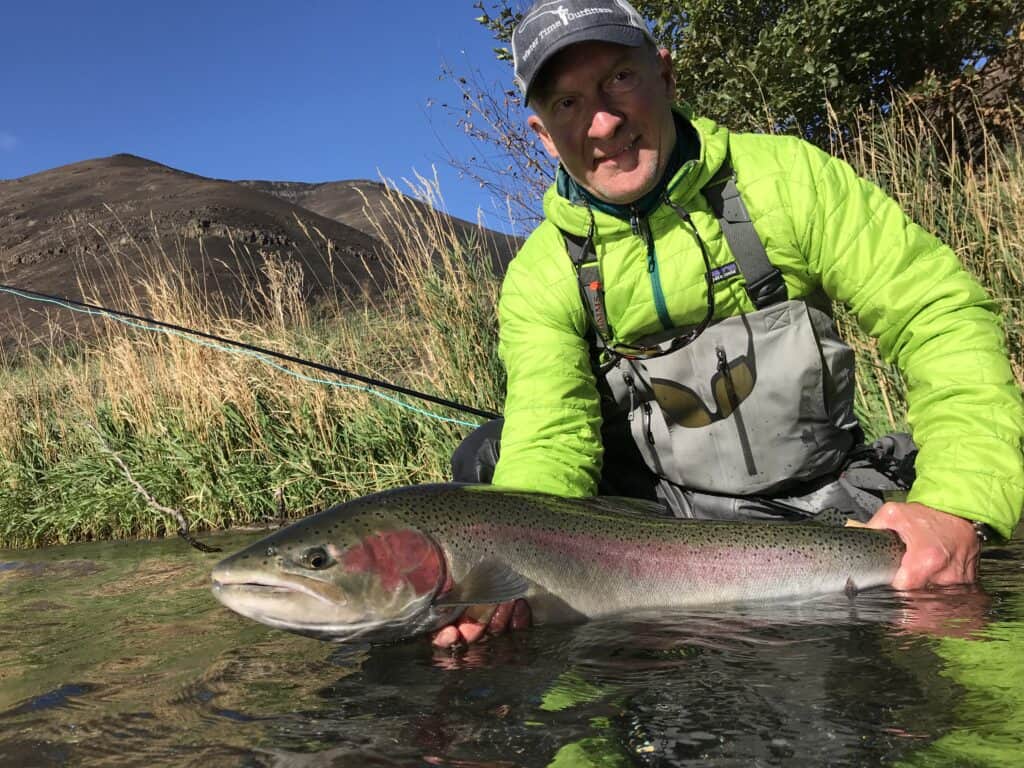
Upriver, above Sherars Falls to the angling deadline at the dam, steelhead fishing is more of a fall event.
Good numbers of Deschutes-bound steelhead start crossing the falls in September, and October typically is the peak of the season around Maupin and upriver. Later fall fishing in November and beyond can be good when the weather allows it.
Fly Fishing for Deschutes River Steelhead
Fly anglers here often use big spey rods for steelhead. If you’d like to try to catch these wonderful fighting fish on a fly, we have you covered with an experienced guide’s tips in Fly Fishing for Deschutes River Steelhead.
For regional summer steelhead fishing information, try our article Best Summer Steelhead Fishing in Oregon’s Mid-Columbia Area.
Learn more about the most reliable conventional and fly fishing techniques to catch steelhead.
Deschutes River Salmon Fishing
Chinook salmon arrive in two runs here. Much of the fishing for both runs is focused below Sherars Falls, a natural braking spot for migrating salmon.
Also, ODFW allows bait fishing in a limited area below the falls, and bait is often the most effective way to catch salmon in the river. Check the regulations for details before fishing with bait, or you’re likely to get a fat fine for using bait in the wrong areas.
Spring Chinook fishing is closed under normal regulations but can be opened in-season using emergency regulations that ODFW enacts when a good run is in the forecast.
When springer seasons open, most of these fish are typically caught in May, maybe into early June. Check out: Spring Chinook Fishing in Central and Northeast Oregon.
Fall Chinook salmon fishing is open under permanent regulations from Sherars Falls to the mouth, again with most of the action close to the falls where bait-fishing is permitted.
This “fall” fishery opens in August and fish numbers build during that month. September and October usually are best for this run.
Coho salmon fishing is open here, but these mid-sized salmon are more of an incidental catch for people targeting the larger and more numerous fall Chinook during September and October.
Baits including salmon roe are often used to catch both Chinook and coho salmon, although lures are also employed, especially for coho.
We have an article that covers simple salmon fishing techniques and tips that will help you catch more big fish.
Other Lower Deschutes River Game Fish
Whitefish are common in this part of the Deschutes, as they are elsewhere in the river. They aren’t targeted as much as trout, steelhead and salmon but can be fun to catch. They often will strike trout flies.
Occasional bull trout are reportedly caught in the lower river, especially closer to the reservoirs, where their numbers are greater and these native fish can drop downriver. These must be released unharmed.
Smallmouth bass are most prevalent in the Deschutes closer to the Columbia River, and that big river is among Oregon’s best smallmouth bass fisheries.
These non-natives aren’t welcome by many in the Deschutes by many anglers and conservationists, and ODFW allows you to keep any number or size of bass you catch here.
Fishing the Middle Deschutes River
The river from Bend downriver to Lake Billy Chinook may be closer to the vacation destinations of Bend, Sisters, and others, but this section flows through rugged and often private land, so access can be tough.
Those anglers who find places to fish will find good numbers of native redside rainbows and whitefish, along with pretty good angling for non-native but naturally reproducing brown trout.
There also are some protected bull trout in the lower section, below Big Falls west of Terrebonne.
This long section of river from Benham Falls (southwest of Bend) to Lake Billy Chinook is open all year for trout and whitefish, but salmon and steelhead fishing is strictly forbidden.
Anglers who fish this area will often do so from mid-winter to mid-spring, when there are good hatches and, if nothing else, the whitefish will keep the action going.
Water draws for irrigation can make this reach tough starting in late spring and may move action to deeper pools.
Access includes Cline Falls and Tumalo state parks. There also are a number of other access points, more if you count some nice spots that require substantial hikes.
Several of the access points on this often overlooked river section are more fully described in “Fishing in Oregon” by Madelynne Diness Sheehan and “Complete Angler’s Guide to Oregon” by John Shewey.
The Benham Falls area includes lots of whitewater, and whatever you do don’t try to boat through these falls, which can be deadly.
Fishing the Upper Deschutes River
This area has many types of water and many sub-sections. ODFW currently allows seasonal fishing from late May through September with limited harvest opportunities for various species found here.
Wickiup Reservoir to Benham Falls
From Wickiup Reservoir down to Benham Falls, the river can provide some excellent fishing for brown trout, including some in the 10-pound range.
These fish-eating predators often strike lures or streamer flies that look like small fish. They tend to be in slower, deeper water and under cut banks.
This section also has the redside rainbows found throughout the Deschutes system, and they tend to like current a bit more than the browns.
You might find an occasional brook trout here, but look upriver for more of those. And there are whitefish.
Fishing the Deschutes Above Wickiup and Crane Prairie Reservoirs
Between Wickiup and Crane Prairie reservoirs, there are some very nice brown trout that move in and out of Wickiup to spawn and feed. This section also serves as spawning grounds for various fish, including Wickiup’s tremendous kokanee population.
The very upper section of the Deschutes, from its beginnings in Little Lava Lake to where it flows into Crane Prairie Reservoir, is primarily fished for native redside rainbow trout and non-native Eastern brook trout.
This is a pleasant place to spend the day fishing with good action and not too crowded conditions in crisp mountain air. This is a smaller stream, with some rushing whitewater sections as well as some meandering meadow parts.
The fish do tend to run small in this high-mountain habitat, most running not much over 10 inches and plenty of them smaller. There are modest harvest limits, at this writing two per day for any trout or kokanee at least 8 inches in length.
There are some bigger fish around, though. The state’s record brook trout, weighing nearly 9 and a half pounds, came from the upper reaches of the Deschutes River.
There also are whitefish and some kokanee that run upstream from Crane Prairie to spawn.
Editor’s note: Many of the patterns in our article Best Fly Fishing Flies in the Pacific Northwest will catch trout and steelhead in the Deschutes River.
Oregon Resources
ODFW Weekly Fishing Report
ODFW Trout Stocking Schedule
Oregon Fishing Regulations
National Weather Service


